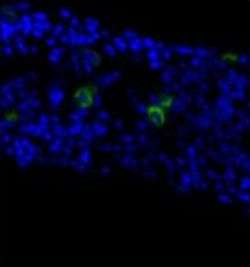Scientists use uterine stem cells to treat diabetes

Controlling diabetes may someday involve mining stem cells from the lining of the uterus, Yale School of Medicine researchers report in a new study published in the journal Molecular Therapy. The team treated diabetes in mice by converting cells from the uterine lining into insulin-producing cells.
The endometrium or uterine lining, is a source of adult stem cells. These cells generate uterine tissue each month as part of the menstrual cycle. Like other stem cells, however, they can divide to form other kinds of cells.
The Yale team's findings suggest that endometrial stem cells could be used to develop insulin-producing islet cells, which are found in the pancreas. These islet cells could then be used to advance the study of islet cell transplantation to treat people with diabetes.
Led by Yale Professor Hugh S. Taylor, M.D., the researchers bathed endometrial stem cells in cultures containing special nutrients and growth factors. Responding to these substances, the endometrial stem cells adopted the characteristics of beta cells in the pancreas that produce insulin. Over the course of a three-week incubation process, the endometrial stem cells took on the shape of beta cells and began to make proteins typically made by beta cells. Some of these cells also produced insulin.
After a meal, the body breaks food down into components like the sugar glucose, which then circulates in the blood. In response, beta cells release insulin, which allows the body's cells to take in the circulating glucose. In this study, Taylor and his team exposed the mature stem cells to glucose and found that, like typical beta cells, the cultured cells responded by producing insulin. The team then injected diabetic mice with the mature, insulin-making stem cells. The mice had few working beta cells and very high levels of blood glucose.
Mice that did not receive the stem cell therapy continued having high blood sugar levels, developed cataracts and were lethargic. In contrast, mice that received the cell therapy were active and did not develop cataracts, but the animals' blood sugar levels remained higher than normal.
Taylor said that the next step in the research will be to verify how long this treatment remains effective. "We will also investigate how changing the nutrient bath or increasing the dose of injected cells could make this treatment more effective," he said. "Endometrial stem cells might prove most useful for Type 1 diabetes, in which the immune system destroys the body's own insulin-producing cells. As a result, insulin is not available to control blood glucose levels."
More information: Citation: Molecular Therapy doi:10.1038/mt.2011.173















